 Abraham Lincoln
If given the truth, the people can be depended upon to meet any national crisis...
Abraham Lincoln
If given the truth, the people can be depended upon to meet any national crisis...
 Guildford news...
for Guildford people, brought to you by Guildford reporters - Guildford's own news service
Guildford news...
for Guildford people, brought to you by Guildford reporters - Guildford's own news service
D-Day Before and Beyond on the Home Front in and Around Guildford
Published on: 6 Jun, 2024
Updated on: 6 Jun, 2024
By David Rose
Eighty years ago today (June 6, 1944) saw the greatest amphibious military operation in history as Allied forces landed in Normandy, France – the start of liberating mainland Europe from Nazi Germany.
The Guildford Dragon NEWS has previously focused on remembering D-Day (Operation Overlord) and its build up in and around the Guildford area, on both the 70th and 75th anniversaries.
I have been collecting stories and information about the home front during the Second World War for as long as I can remember, and every now and then I discover something new. I’m also grateful to others who share information they have found.
Here is another look at that most important part of modern history in and around Guildford.

Churchill tanks being built at Dennis Brothers of Guildford. Picture: Parsons family. No images in this story to be copied and used elsewhere.
Churchill tanks (armoured combat vehicles) took part in the Normandy landings. Following the evacuation of the British Expeditionary Force from the beaches of Dunkirk in 1940, the government commissioned Vauxhall Motors to design a new tank. The first Churchill Mark I model was ready by the summer of 1941 and specialist vehicle maker Dennis Brothers of Guildford was one of the firms who constructed them.

A Churchill tank under construction at Dennis Brothers. Note the woman on the left. The firm employed scores of women during the Second World War. Picture: Parsons family.
Harold George Spratt worked at Dennis Brothers from 1929 to 1961 and collected a number of photos taken inside the factory. His grand, great-grand, and great-great-grand daughters (of the Parsons family) have put the photos and other related material into an album to keep them safe.

Churchill tank being tested on Whitmoor Cmmon, Worplesdon. Picture: Parsons family.
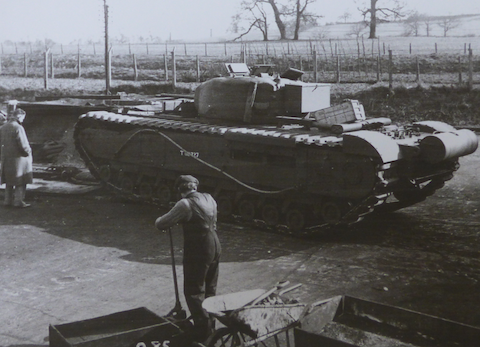
Ready to leave the Dennis Brothers factory, said to be the first Churchill tank off the production line. Picture: Parsons family.
A number of the photos feature the tanks being built in 1941, plus telegrams sent to the firm congratulating the staff on their work.
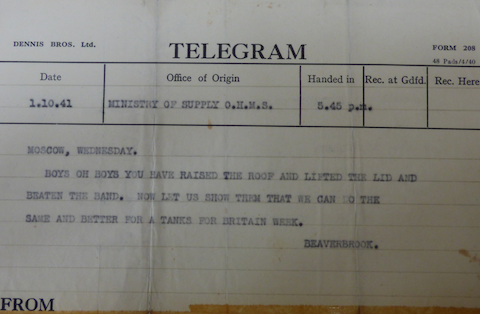
The album also contains telegrams and memos of congratulation sent to Dennis Brothers. These (above and below) sent by Lord Beaverbrook, Minister of Supply. Picture: Parsons family.
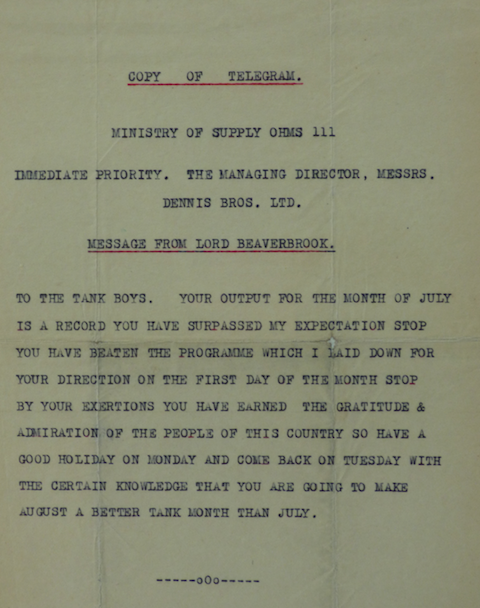
Well worth a walk over Hankley Common near Elstead is to see the remains of the ‘other’ Atlantic Wall.
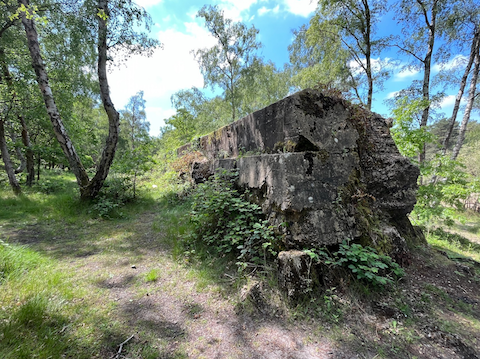
The Allies’ ‘Atlantic Wall’, Hankley Common. Picture: David Rose.
As the plaque reads… it was built in 1943 during the Second World War by Canadian troops as a replica of the German Atlantic anti-tank defences on the northern French coast. It is constructed of concrete and steel rods and wire. Prior to the D-Day landings the wall was used as a major training aid to develop and practise techniques to breach it with explosives.
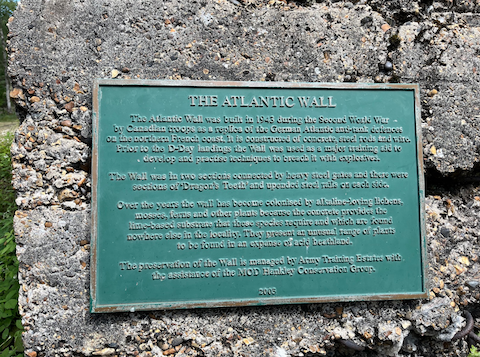
The plaque on the ‘Atlantic Wall’, Hankley Common. Picture: David Rose.
The wall was in two sections connected by heavy steel gates and there were sections of ‘Dragon’s Teeth’ [anti-tank traps] and upended steel rails on each side.
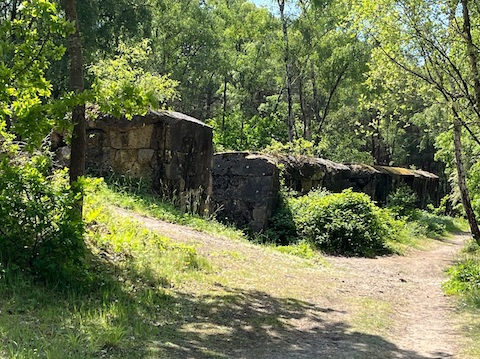
‘Atlantic Wall’ Hankley Common. Picture: David Rose.
Over the years the wall has been colonised by alkaline-loving lichens, mosses, ferns and other plants because the concrete provides the lime-based substrate that these species require and which are found nowhere else in the locality. They present an unusual range of plants to be found in an expanse of acid heathland.
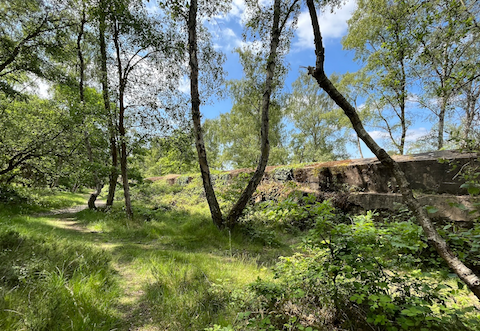
‘Atlantic Wall’ Hankley Common. Picture: David Rose.
The preservation of the wall is managed by Army Training Estates with the assistance of the MOD Hankley Conservation Group.
Movement of troops and vehicles gathered pace as D-Day approached – the south of England was swamped as they moved in, adding to the numerous army units already stationed here.
Historian Frank Phillipson has discovered that prior to D-Day Canadian troops of a “Troop Carrying Unit” were stationed at the Merrow Woods Camp.
They were busy waterproofing their vehicles according to a young evacuee whose family had been blitzed out of their London home and were now housed in a requisitioned newly built house at the beginning of Merrow Woods.
He said that one day the troops were busily going about their various tasks and the next day they had all gone.
Although most national newspapers splashed the news of the Normandy invasion across their front pages, in Guildford the two local newspapers, the Surrey Times and the Surrey Advertiser took a more reserved approach.
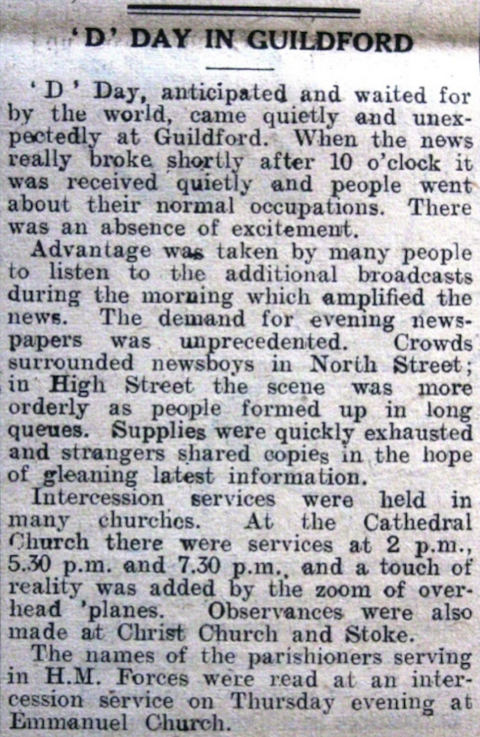
Surrey Times, June 10, 1944
The Surrey Times of June 10, 1944, began its report: ” ‘D’ Day, anticipated and waited for by the world, came quietly and unexpectedly at Guildford.”
 In its edition of June 10, 1944 the Surrey Advertiser went with something similar, under the heading “PRAYERS FOR ALLIED INVADERS WEDDING PARTY JOIN IN”: “News of the Allied landing on the French coast was received quietly in Guildford, but with a sense of relief from tension and with good wishes for the success of the invasion.”
In its edition of June 10, 1944 the Surrey Advertiser went with something similar, under the heading “PRAYERS FOR ALLIED INVADERS WEDDING PARTY JOIN IN”: “News of the Allied landing on the French coast was received quietly in Guildford, but with a sense of relief from tension and with good wishes for the success of the invasion.”
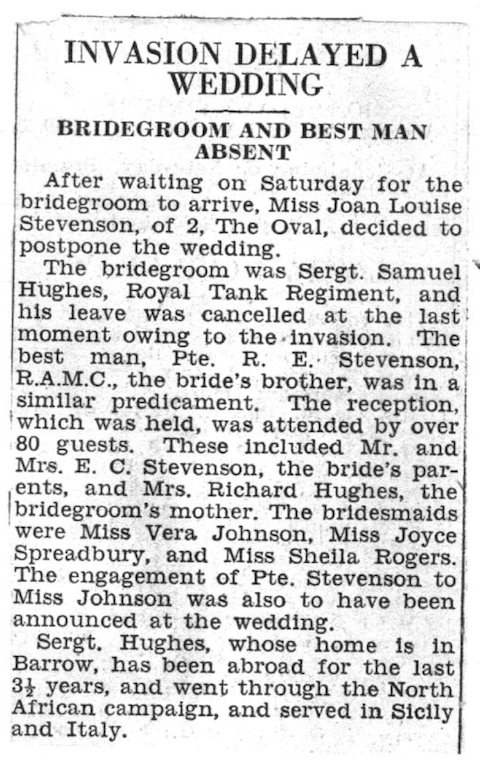 Other local newspaper reports mentioned D-Day in conjunction with some unfortunate setbacks – a wedding being delayed as the bridegroom and best man were absent.
Other local newspaper reports mentioned D-Day in conjunction with some unfortunate setbacks – a wedding being delayed as the bridegroom and best man were absent.
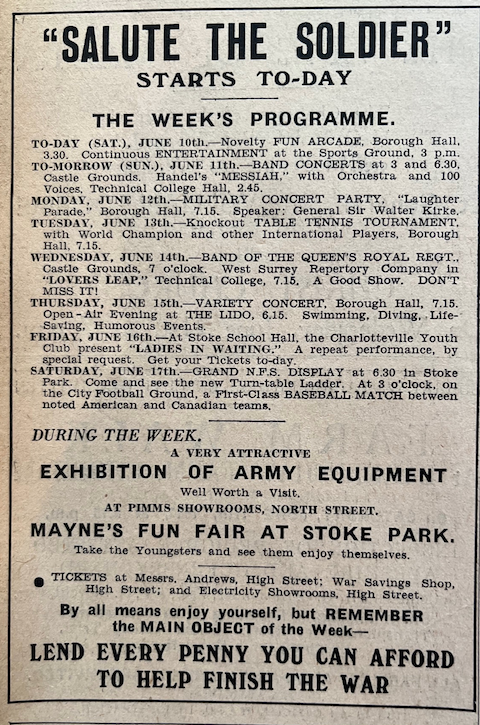
All you needed to know what was going on for Salute The Soldier week.
June 10 to 17, 1944 was Guildford’s Salute The Soldier fundraising week with plenty of events taking place. Perhaps it was timely to take people’s minds off the invasion? Or was it a distraction?
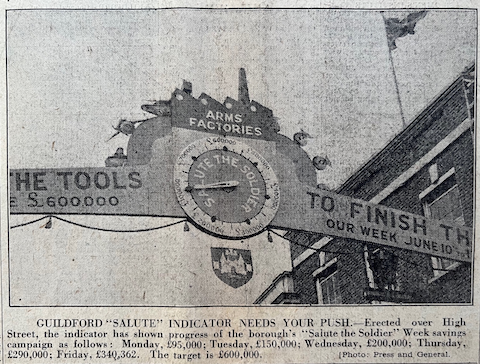 The target was to raise £600,000. In its edition of June 17, 1944 the Surrey Advertiser reported: “Guildford over half-way to ‘Salute’ goal.” The following week’s edition stated the final sum was provisionally calculated to be £561,000.
The target was to raise £600,000. In its edition of June 17, 1944 the Surrey Advertiser reported: “Guildford over half-way to ‘Salute’ goal.” The following week’s edition stated the final sum was provisionally calculated to be £561,000.
As with most of Guildford’s wartime fundraising it was businesses and wealthy individuals who supplied much of the money. However, for Salute the Soldier week, the contributions of “small savings” (funds raised from the many events and from small donations) was a respectable £243,000.
HMS Southdown was an escort destroyer of the Hunt class (Type 1). In 1941 it was adopted by Woking Urban District Council to raise funds towards the vessel’s original cost and fitting out.
She took part in Neptune, the amphibious assault. On D-day+1 (June 7) she is listed as being an escort ship for a convoy of 23 Motor Transport Ships carrying troops from the Thames Estuary across the English Channel to the Normandy beaches in France. On June 8 she escorted another convoy to the Eastern Task Force Area of Normandy where British and Canadian forces were being landed.
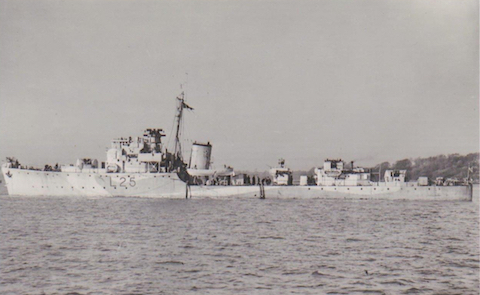
HMS Southdown.
However, by D-Day HMS Southdown had been on active service in the Second World War since November 1940, having been built at J. Samuel White’s shipyard at Cowes on the Isle of Wight.
Woking local history researcher Mark Coxhead has traced the story by looking at microfilm copies of the Woking News & Mail at the Surrey History Centre.
The town’s war savings committee set a target of £400,000. Contributions were largely in the form of investments and loans to the government who encouraged people to buy Savings Stamps and Savings Certificates.
Housewives were encouraged to knit socks and mittens, and make boxes of goodies for the crew of HMS Southdown, and it was decided the last week in February 1942 should be set aside for a special effort to raise the cash to help pay for the ship.
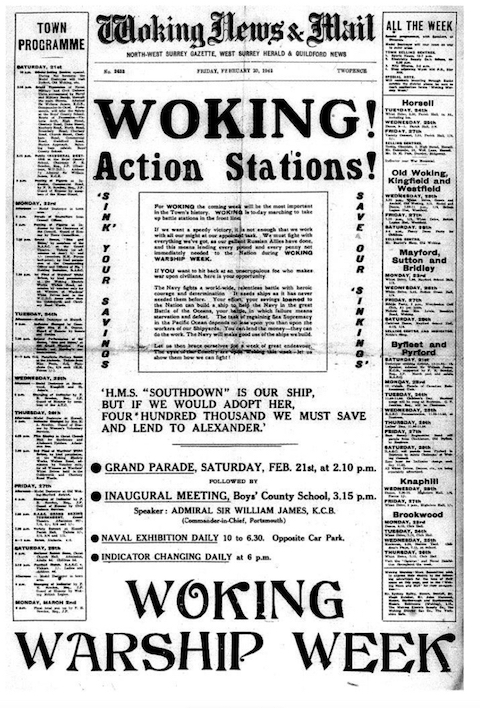
Front-page of the Woking News & Mail of February 20, 1942.
The front-page of the Woking News & Mail of February 20, 1942 contained a full programme of a week of events across the borough with the distinct title of “WOKING! Action Stations!”
The inaugural event was a large parade, said to have been the most imposing spectacle that Woking had ever witnessed.
Although the target had been £400,000, a total of £543,490 had been raised, and therefore assuming a population of 48,000 this amounted to £11, 6 shilling and 6 pence per head.
Returning to news reports following the D-Day landings, in its June 10, 1944 edition the Surrey Advertiser was continuing with reports of the war in Italy with lists of details of men in action reported to have been killed, wounded, or taken prisoner, and so on.
However, it was not long before the Surrey Times began publishing casualty lists from the Normandy campaign. Below are cuttings of some of those stories.
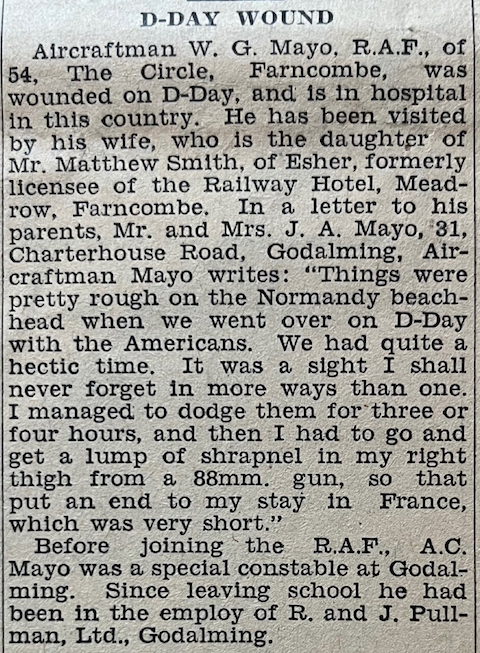
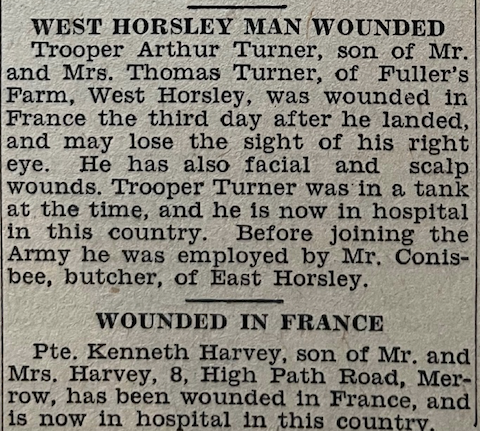

We will remember them.
Responses to D-Day Before and Beyond on the Home Front in and Around Guildford
Leave a Comment Cancel replyPlease see our comments policy. All comments are moderated and may take time to appear.
Recent Articles
- Guildford Institute’s Crowdfunding Project for Accessible Toilet in its New Community and Wellbeing Centre
- Letter: Guildford – Another Opportunity Missed?
- Letter: GBC’s Corporate Strategy – Where Is the Ambition?
- My Memories of John Mayall at a Ground-breaking Gig in Guildford Nearly Six Decades Ago
- Westborough HMO Plans ‘Losing the Heart of the Street’ Says Resident
- College Invests to Boost Surrey’s Economy and Close Digital Skills Gap
- Community Lottery Brings Big Wins for Local Charities
- GBC Housing Plan Promises ‘A Vibrant Urban Neighbourhood’ Near Town Centre
- Hospital Pillows ‘Shortage’ at the Royal Surrey
- Updated: Caravans Set Up Camp at Ash Manor School


Recent Comments
- Ian Macpherson on Updated: Main Guildford to Godalming Road Closed Until August 1
- Sara Tokunaga on GBC Housing Plan Promises ‘A Vibrant Urban Neighbourhood’ Near Town Centre
- Michael Courtnage on Daily Mail Online Reports Guildford Has Highest-paid Council Officer
- Alan Judge on GBC Housing Plan Promises ‘A Vibrant Urban Neighbourhood’ Near Town Centre
- John Perkins on GBC Housing Plan Promises ‘A Vibrant Urban Neighbourhood’ Near Town Centre
- S Collins on GBC Housing Plan Promises ‘A Vibrant Urban Neighbourhood’ Near Town Centre
Search in Site
Media Gallery
Dragon Interview: Local Artist Leaves Her Mark At One of England’s Most Historic Buildings
January 21, 2023 / No Comment / Read MoreDragon Interview: Lib Dem Planning Chair: ‘Current Policy Doesn’t Work for Local People’
January 19, 2023 / No Comment / Read MoreA3 Tunnel in Guildford ‘Necessary’ for New Homes, Says Guildford’s MP
January 10, 2023 / No Comment / Read More‘Madness’ for London Road Scheme to Go Ahead Against ‘Huge Opposition’, Says SCC Leader
January 6, 2023 / No Comment / Read MoreCouncillor’s Son Starts Campaign for More Consultation on North Street Plan
December 30, 2022 / No Comment / Read MoreCounty Council Climbs Down Over London Road Works – Further ‘Engagement’ Period Announced
December 14, 2022 / No Comment / Read MoreDragon Interview: GBC Reaction to the Government’s Expected Decision to Relax Housing Targets
December 7, 2022 / No Comment / Read MoreHow Can Our Town Centre Businesses Recover? Watch the Shop Front Debate
May 18, 2020 / No Comment / Read More









Olly Azad
June 6, 2024 at 12:00 pm
Precious and timeless documents, artefacts and archives from the past that can only be labelled as a “treasure trove,” and together with thr more recent photos of Hankley Common courtesy of David Rose have been fittingly pieced together in time for the 80th anniversary of D-D.
The people of Guildford and the surrounding areas certainly played their part in the war efforts.
Michelle Gardner
June 6, 2024 at 7:14 pm
Hundreds of beacons to be lit around the country this evening, commemorating D-Day, but none in Guildford.